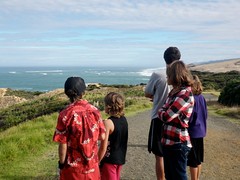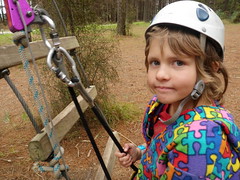A classical education familiarizes the attentive student with the geographical distortions inherent in all maps of our beautiful Earth which are not projected on to a spinning globe. The most famous, of course, is the distortion of the Mercator projection map model wherein Greenland looks like it could swallow North America while Europe looks like it could fit into Washington state. I’m not really much more impressed with the Gall-Peters projection which makes the globe look like it’s having a really sad, depressing and long faced day… though I’ll grant you the relative sizes of the continents are an improvement.
It turns out that there are all sorts of map models. There is one that breaks the world into a bunch of equilateral triangles and one that stretches the poles lengthwise causing Central America to curve around and South America to look like it’s about nine months pregnant.
Yet, what really strikes me about all these maps is how consistently cartographers cut the world right through the Pacific. Map makers declare, “Look! A place we can slit the globe open and smear it flat without chopping any countries in half!” However, I suspect their subconscious is probably noting, “Holy frickin’ hell that’s a big ocean. Let’s just chop it into chunks and hope no one notices.” Because no matter which projection you use, no matter how you cut the world up, the Pacific is just a great big bloody ocean taking up roughly half the planet.
A little noted side-effect of this tendency to cut the Pacific in half is that you end up either chopping New Zealand in half as or losing a chunk of it in the cropping at the edge of the page or somehow failing to include it whatsoever. The result is that most northern hemispherians tend to think of New Zealand as an island off the coast of Australia. Hell, most Americans – who frequently are incapable of naming all 50 states let alone their capitals – don’t even recognize that New Zealand is a separate country. So when I flew from Australia to New Zealand the first time, I was dismayed and surprised to learn that the trip was going to take hours. Many hours and two time zones.
Cartagraphic epiphany number one: New Zealand is a very long way from Australia.
The corollary to this discovery, of course, is a reinforcement of the first argument, “Holy frickin’ hell the Pacific is a big ocean.” I dwell on this quite a bit as my husband blithely reassures me that we’re ready to sail across it next Spring, citing our good friends Hipnautical and Totem and Sea Level as proof that it can be done. Tisk tisk, DrC. Just because we can, doesn’t mean we should! It’s a really long way. Have you looked at a map recently?
But that brings us to cartographic epiphany number two: The Pacific is full of crap.
That’s both a literal and a figurative discovery, mind you. Studying oceans and marine biology with the girls, we are learning more and more depressing stuff about just how much garbage is floating around in the Pacific. There is an island of plastic larger than the state of Texas just swirling around out there waiting for the human species to come to its senses. Fortunately for mariners, it turns out this Trash Island is not a hazard to navigation for the average cruiser on the Coconut Milk Run. There are far more solid and fixed objects to worry about, however. Islands and muotos and all kinds of rocks in the middle of absolutely nowhere just ready to reach up and grab your keel. The big empty blue bits on the edge of your map are chock o’block full of ridges and mountains and plateaus and atolls. An hour with Google Earth in those blank blue bits zoomed down to about commercial airline height is quite an eye opener.
But then in Google Earth I ran into cartographic epiphany number three, which quite literally rocked my world: There is no up.
The thing is that history is written by the winners and so all human history – and hence all the maps – have been written by a bunch of northern hemispherians. Somewhere along the lines someone decided that the North pole is up, and the South pole is down. Quite literally everything flows from that assumption. But what if the cradle of human civilization had been in Australia? What if we started from islands in the middle of the Pacific? What if life actually began in Africa?... wait… it did. Um… Okay, so what if the Africans had actually been asked how they wanted to draw the map? What if South were up, and the planets actually revolved around the sun clockwise?
It is. They do.
Turns out you can flip the world upside. You can invert the entire solar system, in fact, and nothing changes but our perspective. New Zealand and Australia are in the top hemisphere, it’s Winter Solstice today, and sometime next spring we’re going to sail the boat all the way up here. It’ll be a long haul uphill against parental opposition and societal expectation. But when we arrive, we’ll be at the top of the world.
* * *
Editor's Note: I want to thank friend and reader SteveF for posting a link in the comments to this fabulous web site on upside down maps: http://flourish.org/upsidedownmap/. The article is full of fascinating information on the relative and culturally specific nature of maps and includes images of many variations. I'm embedding my personal favorite which is both upside down and does NOT cut the Pacific in half. Thank you SteveF!
It turns out that there are all sorts of map models. There is one that breaks the world into a bunch of equilateral triangles and one that stretches the poles lengthwise causing Central America to curve around and South America to look like it’s about nine months pregnant.
Yet, what really strikes me about all these maps is how consistently cartographers cut the world right through the Pacific. Map makers declare, “Look! A place we can slit the globe open and smear it flat without chopping any countries in half!” However, I suspect their subconscious is probably noting, “Holy frickin’ hell that’s a big ocean. Let’s just chop it into chunks and hope no one notices.” Because no matter which projection you use, no matter how you cut the world up, the Pacific is just a great big bloody ocean taking up roughly half the planet.
A little noted side-effect of this tendency to cut the Pacific in half is that you end up either chopping New Zealand in half as or losing a chunk of it in the cropping at the edge of the page or somehow failing to include it whatsoever. The result is that most northern hemispherians tend to think of New Zealand as an island off the coast of Australia. Hell, most Americans – who frequently are incapable of naming all 50 states let alone their capitals – don’t even recognize that New Zealand is a separate country. So when I flew from Australia to New Zealand the first time, I was dismayed and surprised to learn that the trip was going to take hours. Many hours and two time zones.
Cartagraphic epiphany number one: New Zealand is a very long way from Australia.
The corollary to this discovery, of course, is a reinforcement of the first argument, “Holy frickin’ hell the Pacific is a big ocean.” I dwell on this quite a bit as my husband blithely reassures me that we’re ready to sail across it next Spring, citing our good friends Hipnautical and Totem and Sea Level as proof that it can be done. Tisk tisk, DrC. Just because we can, doesn’t mean we should! It’s a really long way. Have you looked at a map recently?
But that brings us to cartographic epiphany number two: The Pacific is full of crap.
That’s both a literal and a figurative discovery, mind you. Studying oceans and marine biology with the girls, we are learning more and more depressing stuff about just how much garbage is floating around in the Pacific. There is an island of plastic larger than the state of Texas just swirling around out there waiting for the human species to come to its senses. Fortunately for mariners, it turns out this Trash Island is not a hazard to navigation for the average cruiser on the Coconut Milk Run. There are far more solid and fixed objects to worry about, however. Islands and muotos and all kinds of rocks in the middle of absolutely nowhere just ready to reach up and grab your keel. The big empty blue bits on the edge of your map are chock o’block full of ridges and mountains and plateaus and atolls. An hour with Google Earth in those blank blue bits zoomed down to about commercial airline height is quite an eye opener.
But then in Google Earth I ran into cartographic epiphany number three, which quite literally rocked my world: There is no up.
The thing is that history is written by the winners and so all human history – and hence all the maps – have been written by a bunch of northern hemispherians. Somewhere along the lines someone decided that the North pole is up, and the South pole is down. Quite literally everything flows from that assumption. But what if the cradle of human civilization had been in Australia? What if we started from islands in the middle of the Pacific? What if life actually began in Africa?... wait… it did. Um… Okay, so what if the Africans had actually been asked how they wanted to draw the map? What if South were up, and the planets actually revolved around the sun clockwise?
It is. They do.
Turns out you can flip the world upside. You can invert the entire solar system, in fact, and nothing changes but our perspective. New Zealand and Australia are in the top hemisphere, it’s Winter Solstice today, and sometime next spring we’re going to sail the boat all the way up here. It’ll be a long haul uphill against parental opposition and societal expectation. But when we arrive, we’ll be at the top of the world.
* * *
Editor's Note: I want to thank friend and reader SteveF for posting a link in the comments to this fabulous web site on upside down maps: http://flourish.org/upsidedownmap/. The article is full of fascinating information on the relative and culturally specific nature of maps and includes images of many variations. I'm embedding my personal favorite which is both upside down and does NOT cut the Pacific in half. Thank you SteveF!


